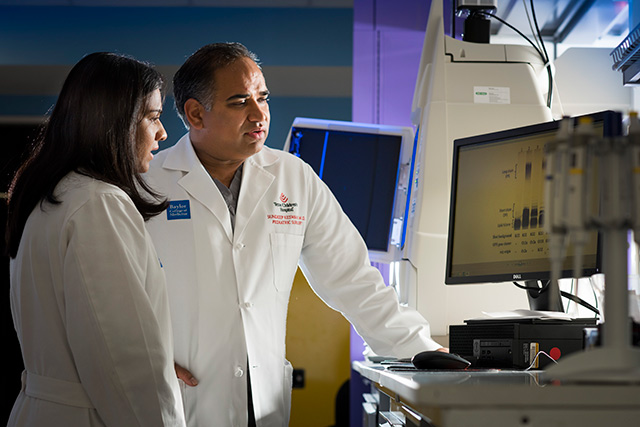 Dr. Sundeep Keswani, surgical director of Basic Research and pediatric surgeon at Texas Children’s Hospital and associate professor of surgery in the Division of Pediatric Surgery at Baylor College of Medicine, was recently awarded a $300,000 grant over a period of three years for his project “Targeting the Extracellular Matrix: an Innovative Strategy to Improve Pulmonary Hypertension in Congenital Diaphragmatic Hernia.”
Dr. Sundeep Keswani, surgical director of Basic Research and pediatric surgeon at Texas Children’s Hospital and associate professor of surgery in the Division of Pediatric Surgery at Baylor College of Medicine, was recently awarded a $300,000 grant over a period of three years for his project “Targeting the Extracellular Matrix: an Innovative Strategy to Improve Pulmonary Hypertension in Congenital Diaphragmatic Hernia.”
The award was from the March of Dimes Foundation, which supports research consistent with its mission to improve the health of babies by preventing birth defects, premature birth and infant mortality. Less than 10 percent of applications submitted annually to the foundation are awarded.
The focus of Keswani’s awarded research is to understand the molecular mechanisms of neonatal pulmonary hypertension and develop new innovative therapies for these patients.
“The data and ideas in this application were developed here at Texas Children’s and are a direct result of the support we have received from the Department of Surgery and the hard work of our team,” Keswani said. “This work illustrates the need for surgeons to engage in basic science research to take observations from the bedside to the bench with the overall goal of improving patient outcomes.”
Keswani is a member of the pediatric surgery and fetal surgery teams at Texas Children’s and the principal investigator for the Texas Children’s Laboratory for Regenerative Tissue Repair. His NIH-funded laboratory was launched about two years ago and spans all 10 surgical divisions at Texas Children’s. Researchers in the lab study the molecular mechanisms of regenerative fetal tissue repair and are actively developing novel therapeutics to achieve postnatal regenerative wound healing.
“Conducting research is essential to provide new techniques and treatments for children’s surgery,” said Texas Children’s Surgeon-in-Chief Dr. Charles D. Fraser Jr. “Dr. Keswani’s recent award from the March of Dimes is an example of how the Department of Surgery is continuing to grow in this area, bringing in new funding and contributing significant research findings. We are committed to basic and translational research by supporting surgeon-scientists at Texas Children’s Hospital.”
Other recent awards garnered by researchers in the Regenerative Tissue Repair Lab include:
Balaji receives Wound Healing Foundation Research Grant
Dr. Swathi Balaji received the 2017 Wound Healing Foundation-FLASH Clinical Wound Healing Grant Award for her proposal titled “Pathogenesis of Cutaneous Fibrosis and Scarring.”
It is unknown why some individuals heal with robust fibrosis and scarring while others heal from similar injuries with less scarring. Balaji and her colleagues want to understand how immunoregulatory factors, particularly lymphocytes, make decisive contributions to dermal fibrosis. They propose that there are fundamental biologic differences in how fibroblasts and lymphocytes crosstalk to influence scar formation in different people. At the completion of this study, their team hopes to better understand how inflammation shapes scar formation and start working towards the development of innovative tools to promote immune regulatory responses in wounds to prevent dermal scarring as well as help other disease processes characterized by excessive fibroplasia.
The Wound Healing Foundation (WHF), through the support of the Wound Reach Foundation presented this award to Balaji at the 2017 Wound Healing Society Annual Meeting in San Diego.
Basic science research conducted by Balaji received national awards
Balaji was this year’s recipient of the ACell Young Investigator Faculty Award presented to a junior faculty member for a research abstract at the Regenerative Medicine Workshop at Hilton Head. Balaji presented a keynote lecture on her work titled “Effect of Stretch on Extracellular Matrix and Morphology of Fibroblasts in Regenerative Wound Healing.”
Tissue repair after an injury can have a spectrum of fibrosis outcomes, and fibroblasts are the major cell type that regulates the extracellular matrix and fibrosis. Even within a single tissue, fibroblasts exhibit considerable functional diversity in response to different environmental factors such as biomechanical tension and inflammation.
Balaji and her colleagues want to explain the signaling mechanisms among fibroblasts that communicate and regulate their fibrogenic phenotype. Their group is studying the role of exosomes, which are microvesicles on the order of 30-150 nm and contain functional biomolecules such as proteins, lipids, RNA, miRNA, as biomarkers and/or targeted therapeutics to regulate the functional diversity of tissue fibroblasts and their cellular cross talk.
Dr. Monica Fahrenholtz, the postdoctoral fellow on this research project, received the Wound Healing Society trainee travel award at the conference. She gave a quick presentation at this year’s annual meeting.

